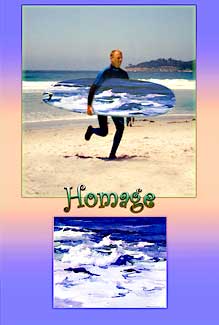|
Steven
Russell, RUAP Community Liaison, interviewed Alvin Takada:
|
SR:
Can you give me a brief overview of the work you did in the 306 class?
AT: Well I have been with the 306 for two semesters. It’s a year
long process and course. So the first semester we just set up a plan decide
what to do. And the following semester we get those plans to work. So
basically I had a really good time working with professors Johanna and
Gilbert. That 306 class was a new course, I never had any experience with
digital especially, so I learned a lot. It was challenging to me, very,
very, challenging. |
SR:
How was the work with the community partner Monterey Museum of Art? How
did that relationship grow between the first and second semester?
AT: Well the first semester was very hard cause we started everything
from scratch. Especially starting with the MMA was a new course for us
to try and decide to do. It was challenging to decide what to do with
them. We had a lot of brainstorming, and how to put a project together
and go from there. The first semester was laid back but uh, a lot of thinking
was happening then. |
SR:
How did that change in the spring semester?
AT: The following semester changed because we started to put our plans
into motion. It was good because we got to really work with the computers,
and it was more fun getting to the actual work. |
SR:
Going from the first process to creating an idea to integrate to the class
and the partner, to the whole process, can you break it down?
AT: Well the first part was the brainstorming, communicating to the museum
back and forth trying to work with them. They were working with our professors
trying to figure out what we (the students) could do. Taking the work
from the Monterey Museum of Art out to the community. That was the first
idea we came up with and started working on. After we decided to work
on that and finding all the material we needed to make it happen. And
communicating with the museum. There was times when were stopped by the
museum’s lack of communication. We did not get that much information
out of the museum, it made it harder on us to work with them. They left
us without guidance. |
SR:
How was the production part, working in Photoshop? Was that a new process
for you and the other students?
AT: That was a new process for me I took some Photoshop classes before
but they were very basic. This one was basic but it is also challenging
cause it takes you to another level of using all the effects and all that
stuff. To me it is a new style to learn, very good and very helpful, especially
the professors who provided a really good help to the students. They were
there day in and out to help the students with the project. A lot of the
students were in the same boat as me so I didn’t feel so alone. The
professors were always there to make sure everything was on the right
track. |
|
|
SR:
Do you think the partnership was a success working with the Monterey Museum
of Art? Do you feel it was a good learning experience?
AT: I think it was a really successful working process. We started from
scratch and ended up with what we wanted to do. We made all the student
work and submitted it and it came out all right. I just feel it was a
really successful two-semester program. |
SR:
Were you happy with your two pieces being displayed at your site?
AT: Yes I am very happy with the results that I got. But there is also
those times that were frustrating, like I said, it was difficult maintaining
communication with the museum. The relationship was very complicated,
so there were times where they left us with no direction. So for me it
was good cause I made some pieces towards the last minute that I had to
change them for copyright reasons. In a way I made what I wanted to do.
I enjoyed it and had a really good time. |
SR:
Do you see yourself working with RUAP again?
AT: Definitely,
I look forward to it every semester. Cause it’s not only that I am
learning new stuff, but also, it’s a challenge to me. I look forward
to the work. It’s not only that I am earning something as a credit.
It is a whole thing working with the community and this is what I want
to do in the future, helping the community. It is a great opportunity,
and also a direction for my future. |
 |



